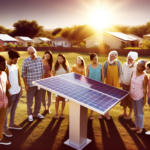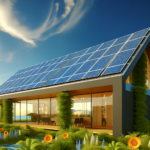Introduction to Solar Energy and Disaster Readiness
Understanding the Importance of Disaster Preparedness
Disaster preparedness is a critical aspect of modern living, as it equips individuals and communities with the necessary tools and plans to respond effectively to emergencies. The increasing frequency and intensity of natural disasters due to climate change, such as hurricanes, wildfires, and floods, underscore the need for robust preparedness strategies. Being prepared can significantly reduce the impact of disasters on human life, property, and the environment. It involves creating emergency plans, building resilient infrastructure, and ensuring access to essential services during and after a disaster.
The Role of Renewable Energy in Enhancing Resilience
Renewable energy sources, particularly solar power, play a pivotal role in enhancing the resilience of communities against disasters. Unlike traditional fossil fuel-based energy systems that are prone to disruption during calamities, renewables offer a more reliable and sustainable energy supply. Solar installations can continue to provide electricity even when the grid fails, ensuring that critical services such as hospitals, emergency response centers, and communication networks remain operational. Moreover, the decentralized nature of solar power reduces the risk of widespread power outages and promotes energy independence.
Overview of Solar Power as a Sustainable Solution
Solar power stands out as a sustainable solution for disaster readiness due to its inherent advantages. It is a clean and inexhaustible source of energy that can be harnessed almost anywhere in the world. Advances in solar technology have made it more affordable and efficient, encouraging widespread adoption. Solar panels can be installed on rooftops, integrated into building designs, or deployed as part of larger solar farms. Additionally, solar power systems can be paired with battery storage to provide a continuous power supply, further enhancing their utility in emergency situations. Embracing solar energy not only contributes to disaster preparedness but also aligns with global efforts to combat climate change and transition towards a greener economy.
The Advantages of Solar Energy in Emergency Situations
Reliability of Solar Power During Outages
When disaster strikes, the reliability of power sources is put to the test. Solar energy emerges as a steadfast ally during such times, providing an uninterrupted power supply even when traditional grids fail. Solar panels generate electricity as long as there is sunlight, making them a dependable source of energy during prolonged outages. Moreover, solar systems equipped with battery storage can offer power during nighttime and overcast conditions, ensuring a continuous energy supply. This reliability is not only crucial for residential areas but also for critical infrastructure such as hospitals and emergency services, where power is indispensable.
Portability and Flexibility of Solar Solutions
The inherent portability and flexibility of solar solutions make them ideal for emergency situations. Portable solar generators, like the Anern Solar Generators, can be quickly deployed to disaster-hit areas, providing immediate relief by powering essential devices such as communication equipment and medical apparatus. These generators are designed to be lightweight and easy to transport, ensuring that help can reach even the most remote locations. The flexibility of solar power also allows for scalable solutions, from small, portable panels for individual use to larger, community-based systems that can power entire neighborhoods.
Reducing Dependence on Traditional Power Grids
One of the key advantages of solar energy is its ability to reduce dependence on traditional power grids. In emergency scenarios, centralized power systems are often compromised, leading to widespread blackouts. Solar energy, being decentralized, can provide localized power generation, minimizing the impact of grid failures. By integrating solar power into their emergency preparedness plans, communities can become more self-sufficient and resilient. This not only ensures access to power during disasters but also contributes to a more sustainable energy landscape by reducing the carbon footprint associated with conventional electricity generation.
Conclusion: Solar energy stands out as a robust and eco-friendly solution in emergency situations. Its reliability during outages, coupled with the portability and flexibility of solar technologies, empowers individuals and communities to withstand power disruptions. Furthermore, by reducing reliance on vulnerable power grids, solar energy enhances overall disaster readiness and promotes a greener, more resilient future.
Eco-Friendly Living and Disaster Preparedness
Integrating Solar Power into Eco-Friendly Lifestyles
Adopting an eco-friendly lifestyle involves making conscious choices that reduce one’s environmental impact. One of the most significant steps in this direction is integrating solar power into daily life. Solar energy can be harnessed in various forms, from rooftop panels to solar water heaters and even solar-powered chargers for electronic devices. By incorporating these technologies, individuals not only contribute to a greener planet but also ensure a level of self-sufficiency in energy production, which is invaluable in times of disaster when conventional power sources may fail.
The Environmental Benefits of Using Solar Energy
Utilizing solar energy offers numerous environmental benefits. It is a clean, renewable resource that reduces reliance on fossil fuels, thereby decreasing greenhouse gas emissions and air pollution. Solar power systems operate silently, eliminating noise pollution, and have a minimal impact on the surrounding ecosystem. Moreover, the scalability of solar solutions means they can be tailored to various settings, from urban to rural, without the need for intrusive infrastructure.
Case Studies: Solar Energy in Disaster-Hit Areas
In the aftermath of natural disasters, solar energy has proven to be a critical component of recovery efforts. For instance, after Hurricane Maria devastated Puerto Rico in 2017, the power grid was left in ruins. Solar companies and nonprofits stepped in to provide portable solar panels and batteries, which became essential for powering medical equipment, refrigerating medicine, and charging communication devices. This not only facilitated immediate relief efforts but also laid the groundwork for a more resilient and sustainable power system for the future.
Similarly, in the wake of the 2011 earthquake and tsunami in Japan, solar power was used to provide electricity to shelters and emergency response teams. The disaster prompted a significant shift in the country’s energy policy, with a greater focus on renewable energy sources, demonstrating how solar power can be a catalyst for long-term change in energy strategies.
These case studies underscore the potential of solar energy not just as an eco-friendly option, but as a reliable and empowering tool in disaster readiness and response, highlighting the importance of integrating solar solutions into both daily life and emergency planning.
Solar Technology for the Adventurous and Off-Grid Living
Essential Solar Equipment for Outdoor Enthusiasts
For those who seek the thrill of adventure and the solace of nature, having reliable equipment is paramount. Solar technology has become an indispensable ally for outdoor enthusiasts. The essential solar-powered gear includes portable solar panels, solar-powered chargers, and solar lanterns. These devices harness the sun’s energy, providing a sustainable source of power for charging GPS devices, smartphones, cameras, and other essential gadgets. A solar backpack can be particularly useful, as it allows adventurers to charge their devices while on the move. Moreover, solar cookers offer a convenient way to prepare meals without the need for fuel, reducing both weight and environmental impact.
Maintaining Energy Independence in Remote Locations
Off-grid living demands a robust and self-sufficient energy system. Solar power stands out as the most viable option for maintaining energy independence in remote locations. The integration of solar panels with high-capacity batteries ensures a continuous power supply, even during periods of low sunlight. Systems like the PowerInPro mobile power generator, with its 5kW power output and 10kWh storage capacity, are designed to meet the energy demands of off-grid living. By combining solar power with energy-efficient appliances and LED lighting, residents can minimize their energy consumption while maximizing the benefits of their solar setup.
Innovations in Portable Solar Technology
The evolution of portable solar technology has been a game-changer for both adventurers and those living off-grid. Innovations in solar panel materials have led to lighter, more efficient, and more durable panels. Foldable and rollable solar panels provide ease of transport and deployment, making them ideal for camping and hiking. Additionally, the advent of solar power banks with integrated battery storage allows for energy to be stored during the day and used at night or during inclement weather. The latest portable solar generators offer AC outlets, USB ports, and even wireless charging, ensuring compatibility with a wide range of devices. These advancements in portable solar technology empower individuals to explore the wilderness or live off-grid without sacrificing the comforts and conveniences of modern technology.
Embracing solar technology for off-grid and adventurous living not only provides energy independence but also aligns with eco-friendly values. By leveraging the sun’s power, individuals can reduce their carbon footprint and contribute to a more sustainable future.
Planning and Implementing Solar Solutions for Emergencies
Assessing Energy Needs and Solar Capacity
When planning for solar solutions in emergency situations, the first step is to assess the energy needs of a household or community. This involves calculating the power consumption of essential devices and systems that must remain operational during an outage, such as refrigeration for food and medicine, lighting, communication devices, and medical equipment. Once the energy requirements are determined, the next step is to evaluate the solar capacity needed to meet these demands. This includes considering factors such as the geographic location, which influences the amount of sunlight available, and the efficiency of the solar panels. It’s also important to account for energy storage solutions, like batteries, to ensure power availability during nighttime or overcast conditions.
Installation and Maintenance of Solar Systems
The installation of solar systems should be carried out by certified professionals to ensure safety and compliance with local regulations. Proper installation is crucial for maximizing energy production and system longevity. Once installed, regular maintenance is necessary to keep the solar system functioning optimally. Maintenance tasks include cleaning solar panels to remove dust and debris, checking and tightening electrical connections, and inspecting the integrity of mounting systems. Additionally, monitoring system performance can help identify any issues early on, allowing for timely repairs and reducing the risk of unexpected failures during emergencies.
Educational Resources for Solar Power Users
Education is key to empowering individuals and communities to effectively use and maintain their solar power systems. A variety of educational resources are available, including online tutorials, workshops, and manuals that cover topics such as system operation, troubleshooting, and conservation strategies to maximize the benefits of solar power. Community programs and local governments often offer training sessions and support networks for new solar power users. Furthermore, partnering with local schools and organizations can help spread knowledge about solar energy and its role in disaster readiness, fostering a culture of sustainability and resilience.
Challenges and Considerations in Adopting Solar Power
Addressing Common Misconceptions About Solar Energy
Despite the growing popularity of solar energy, misconceptions still hinder its widespread adoption. One common myth is that solar panels do not work in cold or cloudy climates. However, solar panels can be effective in various weather conditions; they simply require sunlight, not heat. Another misconception is that solar energy is too expensive. While initial costs can be significant, the long-term savings on energy bills and the availability of incentives often offset the upfront investment. Additionally, some believe that solar panels require excessive maintenance, yet they typically need minimal upkeep, mainly periodic cleaning and inspections.
Navigating Financial and Technical Obstacles
The transition to solar power can be challenging due to financial and technical barriers. The upfront cost of purchasing and installing solar panels can be prohibitive for many homeowners and small businesses. Although the cost of solar technology has decreased over the years, it remains a significant investment. Financing options such as loans, leases, and power purchase agreements (PPAs) are available, but navigating these financial products can be complex.
Technical obstacles also exist. The efficiency of solar panels can be affected by factors such as shading, orientation, and roof condition. Homeowners may need to undertake additional home improvements before installation. Moreover, integrating solar power into existing electrical systems and the grid requires expertise, and finding qualified installers can be a challenge in some regions.
The Importance of Community and Government Support
Community and government support are crucial for the successful adoption of solar power. Government incentives, such as tax credits, rebates, and grants, can make solar energy more accessible and affordable. Community initiatives, like solarize programs, can leverage group buying power to reduce costs and streamline the transition for multiple households simultaneously.
However, inconsistent policies and regulatory challenges can create uncertainty for consumers and businesses. Long-term commitment from policymakers is necessary to provide a stable environment for solar investments. Additionally, community education and outreach are essential to raise awareness about the benefits of solar energy and dispel lingering doubts or misconceptions.
In conclusion, while solar power offers numerous benefits for disaster readiness and eco-friendly living, addressing the challenges of adoption is essential. By overcoming common misconceptions, navigating financial and technical obstacles, and fostering community and government support, we can empower more individuals and communities to embrace solar energy as a key component of their sustainable and resilient future.
Conclusion: Empowering Communities Through Solar Energy
Summarizing the Impact of Solar on Disaster Readiness
The integration of solar energy into disaster readiness strategies has proven to be a transformative approach for communities worldwide. Solar power’s reliability during outages, its portability, and the flexibility of solar solutions have significantly enhanced the resilience of areas prone to natural disasters. By reducing dependence on traditional power grids, solar energy ensures that critical services can continue uninterrupted, providing a lifeline in times of crisis. Moreover, the environmental benefits of solar energy contribute to mitigating the broader impacts of climate change, potentially reducing the frequency and severity of future disasters.
Future Outlook: Solar Innovations and Global Trends
Looking ahead, the future of solar energy is bright, with continuous innovations and global trends pointing towards an increasingly solar-powered world. Technological advancements are making solar panels more efficient, cost-effective, and accessible to a wider range of communities. Energy storage solutions are evolving, allowing for more reliable solar energy systems that can provide power even when the sun isn’t shining. Additionally, the global push for sustainability is driving policy changes and financial incentives that support the adoption of solar energy. As these trends continue, we can expect solar power to play an even more significant role in disaster readiness and sustainable development.
Encouraging Action and Continued Education
To fully harness the potential of solar energy for disaster readiness and eco-friendly living, action and education are key. Communities and individuals must be informed about the benefits and practicalities of solar power. This includes understanding how to assess energy needs, install and maintain solar systems, and navigate financial and technical challenges. Educational resources and community support programs can empower people to make informed decisions and take action. By fostering a culture of knowledge-sharing and collaboration, we can ensure that the benefits of solar energy are realized by all, leading to stronger, more resilient communities.
In conclusion, solar energy stands as a pillar of empowerment for communities, enhancing disaster readiness, supporting eco-friendly lifestyles, and contributing to a sustainable future. As we embrace solar innovations and global trends, we must also encourage action and continued education to maximize the impact of this remarkable energy source. Together, we can build a world where solar power is not just a utility, but a beacon of hope and resilience.





